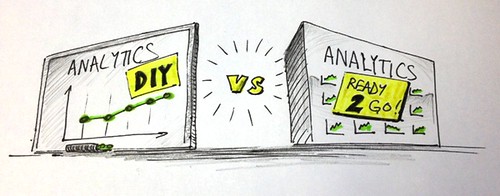If your organization has not yet embraced analytics, you may be wondering “What’s the best way to get started?” A key decision at the beginning is whether or not to bring in outside expertise to kick start the process, versus the traditional approach of recruiting an internal team. Another key decision is “Which analytics software should we buy?” This post outlines some tips that executives can use to move forward.
If your organization has not yet embraced analytics, you may be wondering “What’s the best way to get started?” A key decision at the beginning is whether or not to bring in outside expertise to kick start the process, versus the traditional approach of recruiting an internal team. Another key decision is “Which analytics software should we buy?” This post outlines some tips that executives can use to move forward.
Tip 1: Buying analytics software shouldn’t be your first step
There’s an incredible array of analytics software available in the market, many of which are marketed as turn-key solutions. The idea of an off-the-shelf solution appeals to a lot of business leaders … they are drawn towards the idea of a having a tangible asset that works right out of the box, without having to worry about the pesky people issues.
But, there are a lot of negatives that come with this approach:
- The tool is only as good as the strategic thinking that goes into how it will be used. If you run an analytics tool on poor or incomplete metrics the tool doesn’t have a chance of creating business value.
- The tool is only as good as the analyst running it. The analyst is the interface between the real business problem, and how that business problem is translated into the data and metrics in your system. If that translation is poor, then the tool is unlikely to generate powerful results.
- The tool will quickly be discarded if it’s not generating business value. This will create a belief within the organization of “been there, done that … we tried analytics and it doesn’t work for us”. This can mean that your organization will fall behind the competition.
Tip 2: Think hard before recruiting from within
It’s not uncommon for an organization to build their analytics team with their existing staff. This approach increases the chance that your analytics team will get what your business is about, and hopefully they also represent the culture of your organization.

A challenge with this approach is that the team members who are recruited from within are often not able to give full attention to their new position, because they are still holding responsibilities related to their old roles. Another challenge with this approach is that there’s a risk of missing a big opportunity to take a fresh look at how the organization uses analytics to drive their key decisions. For example, if you recruit from your finance department, chances are that your analytics will be very financially focused. These concerns can be overcome, but it certainly helps to think about these considerations before making a decision.
Tip 3: Find a recruiter you can trust
If you’re building up a new team with external hires, getting the ball rolling can be tricky. Most organizations start by hiring the team leader, and then ask the team leader to do all of the following recruiting. A challenge with this approach is that whoever is hired first often sets the possibilities and the limitations of the team. For example if the first hire is a fan of traditional multivariate statistical approaches, chances are they will pursue analytics applications in that area, while leaving all other opportunities behind. They will create demand for their favorite analytics applications, and therefore hire other team members that have that same skills set (i.e. “he who has a hammer sees everything as a nail”).
So, the first hire with this approach is a crucial one, and given the specialized and nichy aspect of analytics, this will be a hire that you’ll likely do best to work with a recruiter that you trust. If you are successful in hiring a strong team leader, think about using the Who Method for setting targeted outcomes for the first 90, 180, and 365 days. These outcomes should reflect the business value that your organizations wants to get out of having its’ own analytics team.
Tip 4: Find an analytics consulting firm you can trust
The alternative approach would be to start off with an external consulting firm that specializes in analytics, and do a demonstration project with them. This approach is especially useful, as it allows you to start off with an experienced team and make progress quickly. This both increases the range of analytics that can be considered, and increases the chance of having a successful first project.
To get even more value out of working with an analytics consulting firm you can look at options for them to help you move towards building your own team. You can ask them:
- Based on the work they do with you, can they build a “leave behind” tool that allows you to update the results yourself?
- What insights do they have on your local job market for analytical talent?
- Could they support you in building a recruiting plan?
Often leaders are hesitant to bring in an outside consulting firm because they don’t know what to look for, and they are worried about hiring the wrong firm, and/or asking for the wrong type of support. But what is less risky … hiring a consulting firm to do a “prove yourself” demonstration project, or building up a team of full-time staff with a completely new area of expertise?
Either way it’s generally better to focus on your people and processes first, and then afterwards, figure out the analytics software they need to do their job. Building an analytics capability in an organization takes a while. There are more things that can go wrong than go right. If you take a long term view, it makes sense to begin small (both with people and projects), realize some early wins, and gradually build the team based on the business value that they generate.
If you have stories about how you built your analytics team, please share them.








